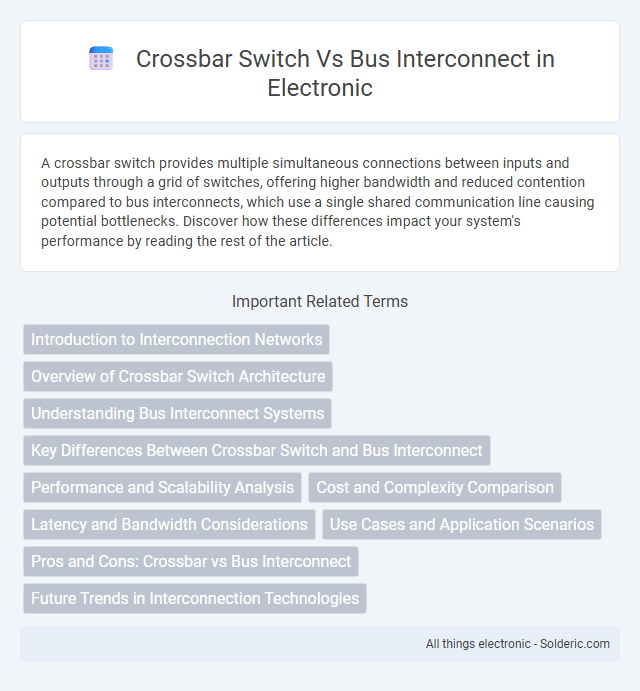A crossbar switch provides multiple simultaneous connections between inputs and outputs through a grid of switches, offering higher bandwidth and reduced contention compared to bus interconnects, which use a single shared communication line causing potential bottlenecks. Discover how these differences impact your system's performance by reading the rest of the article.
Comparison Table
| Feature | Crossbar Switch | Bus Interconnect |
|---|---|---|
| Topology | Matrix with dedicated paths between all inputs and outputs | Single shared communication line for all devices |
| Scalability | Highly scalable for large numbers of devices | Limited scalability due to shared bandwidth |
| Performance | High throughput with simultaneous multiple connections | Lower throughput due to bus contention |
| Complexity | High hardware complexity and cost | Simple and cost-effective design |
| Latency | Low latency due to dedicated links | Higher latency caused by bus arbitration |
| Usage | Used in high-performance computing and routers | Common in small-scale or cost-sensitive systems |
Introduction to Interconnection Networks
Interconnection networks such as crossbar switches and bus interconnects play a crucial role in facilitating data transfer between multiple processing units and memory modules. Crossbar switches provide dedicated point-to-point connections that enable simultaneous, high-bandwidth communication between multiple inputs and outputs, significantly reducing contention and latency. Bus interconnects use a shared communication pathway where all devices compete for access, which limits scalability and bandwidth due to collisions and arbitration delays.
Overview of Crossbar Switch Architecture
Crossbar switch architecture features a grid of intersecting horizontal and vertical lines, enabling simultaneous data transfer between multiple input-output pairs without contention. Each intersection contains a switch element that can be independently controlled, allowing dynamic connection paths and high throughput for parallel processing. Unlike bus interconnects, which share a single communication line, crossbar switches offer scalable bandwidth and reduced latency by enabling multiple concurrent transfers.
Understanding Bus Interconnect Systems
Bus interconnect systems use a shared communication pathway that connects multiple devices, enabling sequential data transmission but often causing bottlenecks as more devices compete for bandwidth. Crossbar switches provide dedicated pathways between all input and output ports, allowing simultaneous data transfers which improve overall system throughput and reduce latency. Understanding these differences highlights the trade-offs in scalability and performance between bus interconnects and crossbar switch architectures in high-speed computing environments.
Key Differences Between Crossbar Switch and Bus Interconnect
Crossbar switch offers multiple simultaneous data paths enabling higher throughput and parallel data transfer, whereas bus interconnect uses a single shared communication line limiting bandwidth and causing possible contention. The crossbar switch's complexity and cost are higher due to dedicated switching elements, while bus interconnect remains simpler and more cost-effective for smaller systems. Your choice depends on performance needs, with crossbar switches suitable for high-performance computing and bus interconnects better for simpler, cost-sensitive designs.
Performance and Scalability Analysis
Crossbar switches offer superior performance with simultaneous full-duplex communication between multiple nodes, reducing contention and latency compared to bus interconnects that serialize traffic and create bottlenecks. Scalability is enhanced in crossbar architectures by allowing increased ports with minimal performance degradation, whereas bus systems face significant bandwidth limitations and increased arbitration complexity as more devices are added. Crossbar switches therefore provide optimal throughput and low latency in high-demand applications, while buses remain suitable for simpler, low-speed environments.
Cost and Complexity Comparison
Crossbar switches incur higher costs due to their dedicated point-to-point connections, requiring more hardware resources as the number of nodes increases, leading to increased complexity in design and scalability. Bus interconnects offer a more cost-effective and simpler architecture with fewer physical lines and easier expansion but suffer from bandwidth limitations and higher contention as multiple devices share the same communication medium. The trade-off between cost-efficiency in bus systems and high-performance scalability in crossbar switches significantly impacts their suitability for different computing environments.
Latency and Bandwidth Considerations
Crossbar switches offer significantly lower latency and higher bandwidth compared to bus interconnects by allowing simultaneous data transfers between multiple input-output pairs without contention. Your system benefits from improved scalability and reduced bottlenecks as each connection operates independently within the crossbar architecture. In contrast, bus interconnects suffer from increased latency and limited bandwidth due to shared communication paths and signal arbitration delays.
Use Cases and Application Scenarios
Crossbar switches excel in high-performance computing and data centers where low latency and simultaneous multi-device communication are critical, supporting parallel data transfers without contention. Bus interconnects are suitable for simpler, cost-effective systems like embedded devices or small-scale networks where moderate bandwidth and sequential data access are sufficient. Your choice depends on the required scalability and throughput, with crossbars favored for complex data routing and buses ideal for straightforward, lower-demand applications.
Pros and Cons: Crossbar vs Bus Interconnect
Crossbar switches provide high-speed, simultaneous data transfers with dedicated paths between multiple inputs and outputs, minimizing contention and maximizing throughput in complex systems. Bus interconnects offer simpler, cost-effective designs but suffer from bandwidth limitations and increased contention as multiple devices share the same communication medium. Crossbar systems excel in scalability and performance for high-demand environments, while bus interconnects remain suitable for simpler, low-cost applications with modest data transfer requirements.
Future Trends in Interconnection Technologies
Crossbar switches offer scalable, high-bandwidth paths that support increasing data demands in many-core processors, while bus interconnects face limitations in speed and contention as node numbers grow. Future trends emphasize hybrid architectures combining crossbar flexibility with bus simplicity to balance latency and power efficiency, alongside emerging optical and wireless interconnects enhancing bandwidth and reducing wiring complexity. Your next-generation system design should consider these advancements to optimize performance, scalability, and energy consumption in evolving computational workloads.
Crossbar switch vs bus interconnect Infographic

 solderic.com
solderic.com